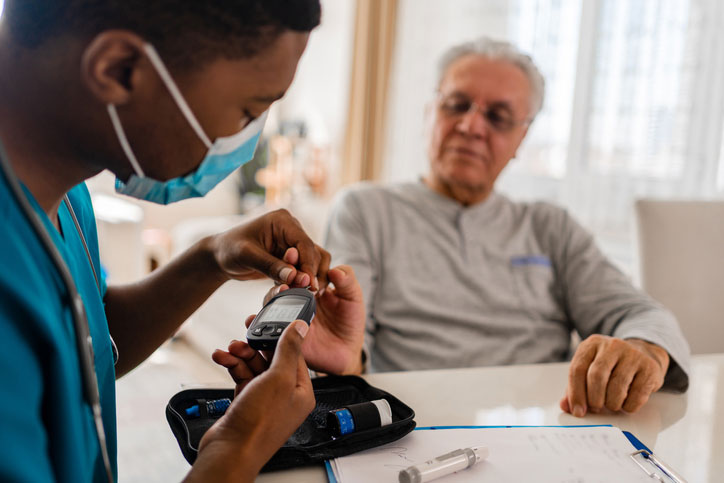An HCDI Healthy People 2030 Spotlight: Diabetes Management and Prevention
By HCDI Communications
This month is American Diabetes Awareness Month, where we bring awareness to the more than 37 million Americans living with diabetes and the 96 million with prediabetes.
 Diabetes is a serious health condition that affects how your body produces insulin. There are three different types of diabetes – Type 1, Type 2, and Gestational. While Type 1 can be diagnosed at any age, Type 2 develops over time due to an unhealthy lifestyle. Gestational diabetes is brought on with pregnancy and usually goes away once the baby is born; however, it places babies at risk of developing obesity and diabetes later in life.
Diabetes is a serious health condition that affects how your body produces insulin. There are three different types of diabetes – Type 1, Type 2, and Gestational. While Type 1 can be diagnosed at any age, Type 2 develops over time due to an unhealthy lifestyle. Gestational diabetes is brought on with pregnancy and usually goes away once the baby is born; however, it places babies at risk of developing obesity and diabetes later in life.
People who eat too many unhealthy foods that are high in saturated fat and added sugars are at increased risk for obesity and diabetes. Diabetes can lead to serious health problems over time, including heart disease, vision loss, kidney disease, and leg or foot amputations, if not properly treated. While there isn’t a cure for diabetes, eating healthy, exercising, and taking prescribed medicine can help manage the disease. Although diabetes is the seventh leading cause of death among Americans, many do not know they have it; therefore, the Office of Disease Prevention and Health Promotion’s Healthy People 2030 focuses on diabetes management and prevention.
Healthy People 2030 was designed by the U.S. Department of Health and Human Services (HHS) to help people across the country improve their quality of health. The program provides health literacy and social support information for those facing Social Determinants of Health (SDoH) challenges, such as living in unsafe or rural neighborhoods and difficulty affording or accessing basic needs, like healthy food and medicines. Many within these vulnerable populations do not eat a healthy, balanced diet or are unable to see a doctor or acquire necessary medications due to their SDoH barriers and this can negatively impact their overall health and lead to serious health conditions like diabetes. Some racial/ethnic minorities, including American Indians, African Americans, and Hispanics, are more likely to have diabetes as well.
Healthy People 2030 Diabetes Goal and Objectives
Healthy People 2030 focuses on reducing the burden of diabetes and improving quality of life for all people who have or are at risk for diabetes through a series of objectives. The objectives concentrate on reducing diabetic cases, deaths, and undiagnosed prediabetes as well as increasing formal diabetes education, insulin usage and blood sugar monitoring, and routine eye exams for diabetic retinopathy screening. Improvement is necessary for all noted objectives to reduce the burden of diabetes among all U.S. populations.
| Objective | Recent | Target | Baseline | Result |
| Reduce the number of diabetes cases diagnosed yearly | N/A | 4.8 per 1,000 adults |
5.5 new cases per 1,000 adults (2019-2021) |
Baseline data only |
| Reduce the rate of death from any cause in adults with diabetes | N/A | 13.7 per 1,000 people | 15.2 deaths per 1,000 people with diabetes
(2010-15) |
Baseline data only |
| Reduce the proportion of adults who don’t know they have prediabetes | 41.3%
(2017-20) |
33.2% | 38% of adults had undiagnosed prediabetes
(2013-16) |
Little to no detectable change |
| Increase the proportion of people with diabetes who get formal diabetes education
|
55.1% (2019) |
55.2% | 51.7% of adults with diabetes received formal diabetes self-management education and support (DSME) (2017) | Little to no detectable change |
| Increase the proportion of adults with diabetes using insulin who monitor their blood sugar daily | 86.5% (2019) | 94.4% | 89% of adults with diabetes use insulin performed self-monitoring of blood glucose at least once daily (2017) | Little to no detectable change |
| Increase the proportion of adults with diabetes who have a yearly eye exam | 58.3% (2020) | 70.3% | 64.8% of adults with diabetes had an eye exam within the past 12 months (2019) | Getting worse |
Healthy People 2030 Solutions to Reduce the Burden of Diabetes
To alleviate the burden of diabetes among Americans, Healthy People 2030 emphasizes the need for programs to educate people in the treatment of diabetes. Diabetics who control their blood sugar levels with medication treatments, such as insulin, along with proper nutrition and physical activity can prevent serious health complications like amputations. For those at risk of prediabetes, educational interventions to help people eat healthier, exercise, and lose weight can prevent new cases from happening and lower the death rate.
Many people with diabetes, especially in minority populations, don’t get yearly eye exams. A common eye disease among diabetics is diabetic retinopathy, which can lead to blindness if not treated. Healthy People 2030 finds routine eye exams can pinpoint diabetic retinopathy early, when it is easier to treat, and prevent vision loss.
HCDI Provides Diabetes Health Education and Schedules Diabetic Retinal Eye Exams
HCDI International manages a Diabetes Center of Excellence (DCOE) online offering diabetes health education and prediabetes healthy lifestyle coaching through its Maryland-based Diabetes Prevention Program (DPP). HCDI recruits DPP cohorts each year through a prediabetes risk assessment. Cohorts meet weekly for several weeks to support healthy eating habits and physical activity. HCDI provides lifestyle coaching so participants develop healthy meal and exercise plans. The goal of the program is to reduce the number of diabetes cases and deaths and to improve the health of our most vulnerable within the state of Maryland.
In addition to managing a DCOE and local DPP program, HCDI also engages with members of a well-known health plan to schedule diabetic retinopathy exams for their members. During these calls, our community health workers (CHWs) ensure members are educated on the importance of diabetic retinal eye exams for the early detection of diabetic retinopathy and the prevention of vision loss. Additionally, our CHWs will host diabetic retinal eye exam community events for the health plan provider throughout the year to screen residents with diabetes.
To learn more about HCD International’s health equity engagements with state health departments and government-sponsored health plans, visit hcdi.com or contact us directly at info@hcdi.com.
What is Healthy People 2030
Originating in 1979, the Healthy People initiative began when the United States Surgeon General Julius Richmond issued the “Healthy People: The Surgeon General’s Report on Health Promotion and Disease Prevention.” Led by the U.S. Health and Human Services’ Office of Disease Prevention and Health Promotions, Healthy People 2030 emerged in 2020 as the fifth iteration addressing the latest public health priorities.
The mission of Healthy People 2030 is “to promote, strengthen, and evaluate the nation’s efforts to improve the health and well-being of all people” with a vision to cultivate a society where all people can achieve their full potential for health and well-being. Healthy People 2030 encompasses 359 core, measurable objectives along with developmental and research objectives, with 23 leading health indicators, to improve health outcomes over the next decade. Objectives include baseline data from, in most cases, no earlier than 2015 and is extracted three times throughout the duration of the decade from over 80 federal, Health and Human Services (HHS) and non-HHS data systems. Topics covered span from health conditions to health behaviors, populations, settings and systems, and social determinants of health.
To learn more about Healthy People 2030, visit health.gov/healthypeople.






